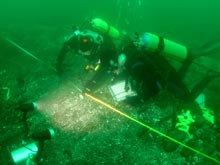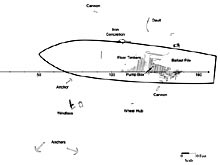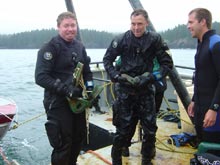
The shipwreck was positively identified when archaeologists discovered the
hub of the ship's wheel bearing the name Kad'yak in Cyrillic - ![]() .
Click image for larger view and image credit.
.
Click image for larger view and image credit.
The Kad'yak's wooden hull has deteriorated since it sank in 1860. Archaeologists, working in 47 degree water, carefully draw the timbers used to build the ship's the lower hull. Click image for larger view and image credit.
Kad'yak 2004 Exploration
Frank Cantelas
Maritime Archaeologist
East Carolina University
Jason Rogers
Maritime Studies Program
East Carolina University
A new three masted bark christened the Kad'yak slid down the ways at the Hans Jacob Albrecht Meyer shipyard in Lübeck, Germany in 1851. Built for the Russian-American Company, the ship was destined to sail around Cape Horn and spend its career in the north Pacific. Throughout the first half of the nineteenth century the Russian-American Company established settlements in Alaska, initially to trap furbearing animals. Later, these settlements became largely self sufficient by taking advantage of Alaska's tremendous natural resources. Company ships sailed half way around the world to provide luxury items not available locally and brought news from home. These "round the world" ships arrived in Alaska about once a year. The Kad'yak traveled that route on her maiden voyage and served in Alaska for nine years before sinking near Kodiak Island.
Alaska has a tremendous coast line stretching 44,000 miles and includes many bays, harbors and islands. The Russians who colonized the region established a maritime economy based on moving supplies and trade goods by water instead of over land. They harvested many marine resources including fish, whales, seals, and otters. This concentration on marine travel and resource extraction required a dependence on many different kinds of water craft. The Russians used small kayaks and biadarkas and also sailing ships and coastal steamers. The Kad'yak was part of the Russian-American Company fleet of larger vessels.
Kad'yak was built as a bark-rigged sailing vessel that carried three masts and measured roughly 130 feet long by 30 feet wide with a 20 foot depth of hold. Thin copper sheets were nailed to the bottom of the Kad'yak to prevent barnacles from growing. Marine organisms that grow on the bottom of ships cause drag and slow the vessel down. These thin copper sheets are still present on the shipwreck attached to the wooden hull.
Kad'yak sailed in the Russian-American Company fleet in the final years before the United States purchase of Alaska in 1867. Based at company headquarters in Novo-Archangelsk (Sitka), Kad'yak carried trade goods between Russian settlements in Alaska and made trading voyages to the Hawaiian Islands. The usual complement of the ship consisted of employees of the Russian-American Company including Native Americans.
On her final voyage, the Kad'yak loaded a cargo of ice for shipment to San Francisco, where the Russian-American Company enjoyed a profitable trade with gold-seekers. The Kad'yak left Sitka for the final time on February 27, 1860, to pick up a cargo of 356 tons of ice at Kodiak. On putting to sea from Kodiak harbor on March 30, the vessel hit an uncharted submerged rock and immediately filled with water. The captain, a Creole named Illarion Arkhimandritov, the officers, and crew took to the ship's boats. The Kad'yak, kept afloat for three days by her cargo of ice, drifted towards Spruce Island and sank in Icon Bay on April 2, 1860. The mast of the ship protruded above the water with a single yard forming the shape of a cross, visible from the shrine of Father Herman (later St. Herman) on the shore of Spruce Island, giving religious significance to the story of the vessel's misfortune. According to legend, the Kad'yak's captain failed to fulfill his promise to venerate relics of this famous monk in Kodiak Cathedral prior to his departure from the island. The circumstances of the Kad'yak's wrecking made her an object of religious importance, and thus she entered the local lore and legend of the island. Several months later, Captain Arkhimandritov was commissioned to chart the coast of Spruce Island. His notes with the compass bearings for the protruding mast of the Kad'yak allowed Dr. Bradley Stevens, of the NOAA Kodiak Fisheries Research Center, to lead an expedition that discovered the site of the Kad'yak wreck in July 2003.
A group of researchers led by nautical archaeologist Frank Cantelas from the Maritime Studies Program at East Carolina University completed an archaeological documentation of the Kad'yak shipwreck site in July of 2004. The expedition included faculty and students from the university, scientists from the NOAA Kodiak Fisheries Research Center, Alaska's State Archaeologist and numerous volunteers. The National Science Foundation provided a grant to complement funding from the Office of Ocean Exploration.
Today the Kad'yak lies in 80 feet of water on a sandy and rocky bottom between two submerged ridges. Father Herman's chapel is just a short boat ride away. Due to wood eating marine organisms and stormy seas, the vessel has been considerably reduced from its original form. A portion of the wooden hull remains only because it was buried under the sand. A Cannon, anchors, a windlass, portions of the rudder and other iron and bronze artifacts lay scattered on the bottom where they fell as the ship deteriorated. One artifact, discovered on the third day of the project, identified the ship. This artifact, made of wood and brass, has the name Kad'yak imprinted in Cyrillic on a brass cap.
The research team comprehensively documented the site making detailed drawings of features and artifacts along with extensive photo and video recording. This information has been used to research the Kad'yak's history and interpret the vessel in light of its use by the Russian-American Company in Alaska. It is the only shipwreck from the colonial Russian period in the United States and has been listed on the U.S. Department of Interior's National Register of Historical Places for the significant role it played in Alaska's history.




